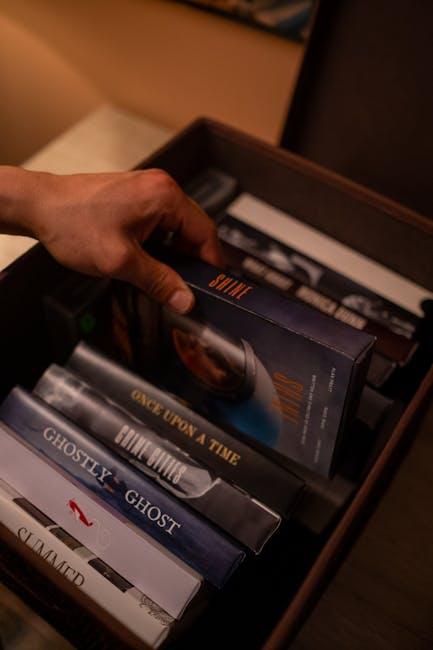Cinema, an art form born from flickering images and dreams, has the power to transport us across time, space, and emotion. As we traverse the vast landscape of film history, certain masterpieces stand as towering monuments, each a testament to the creative brilliance and pioneering spirit of their time. In this exploration, we delve into five classic films that not only define their respective eras but also invite us to marvel at the evolution of storytelling through the lens of a camera. These cinematic gems serve as both a tribute to the past and a beacon guiding us toward a deeper appreciation of the rich tapestry that is cinema’s history. Join us as we journey through these timeless classics, each offering a unique perspective that enriches our understanding of the art and craft that have shaped the world of film.
Rediscovering Cinematic Masterpieces Through Timeless Storytelling
In the realm of cinema, where visual storytelling transcends the boundaries of time, certain films stand as monumental achievements that have shaped the very fabric of the art form. These masterpieces not only offer a glimpse into the creative genius of their creators but also continue to inspire and influence filmmakers today. Delve into these timeless narratives and discover how they have etched their indelible mark on the history of cinema.
- Casablanca (1942): An epitome of classic Hollywood romance, this film weaves a tale of love and sacrifice set against the backdrop of World War II. Its memorable dialogue and iconic performances have made it a benchmark for cinematic storytelling.
- Citizen Kane (1941): Heralded as one of the greatest films ever made, Orson Welles’ masterpiece is a pioneering work in narrative structure and cinematography, offering a complex portrait of ambition and power.
- Lawrence of Arabia (1962): With its breathtaking visuals and epic scale, this film explores the enigmatic character of T.E. Lawrence, presenting a rich tapestry of historical drama and personal introspection.
- The Godfather (1972): A cornerstone of modern cinema, this film’s intricate exploration of family, loyalty, and power continues to resonate with audiences, offering a compelling narrative that is as captivating today as it was upon release.
- Vertigo (1958): Alfred Hitchcock’s psychological thriller remains a mesmerizing exploration of obsession and identity, masterfully crafted with innovative camera techniques and a haunting score.

The Art of Filmmaking: Lessons from the Silver Screen
The journey through cinema’s rich tapestry is incomplete without delving into the masterpieces that shaped the industry. These classic films not only entertain but also educate us on the transformative power of storytelling. “Citizen Kane” (1941) is a cornerstone of innovation, with Orson Welles’ groundbreaking techniques in cinematography and narrative structure. Its exploration of power and loss remains a benchmark for aspiring filmmakers. “Casablanca” (1942), with its unforgettable dialogue and timeless romance, demonstrates the art of blending personal stories with larger historical contexts.
- “The Godfather” (1972): A masterclass in character development and storytelling, this film redefined the crime genre and continues to influence filmmakers today.
- “Gone with the Wind” (1939): Its sweeping visuals and complex characters showcase the epic potential of cinema, setting standards for production design and scale.
- “Psycho” (1960): Alfred Hitchcock’s thriller not only introduced new levels of suspense but also revolutionized the horror genre with its psychological depth and innovative use of sound.
These films serve as a testament to the enduring legacy of cinema, each offering unique lessons in narrative, technique, and emotional resonance. By studying these classics, we gain a deeper appreciation for the artistry that continues to inspire filmmakers across generations.

Visual Elegance and Innovation in Classic Cinema
In the realm of classic cinema, the seamless blend of visual elegance and groundbreaking innovation serves as a testament to the enduring power of film. These masterpieces not only shaped the landscape of cinema but also elevated storytelling to an art form. As we explore these cinematic treasures, we uncover a world where directors harnessed the magic of light and shadow, actors conveyed emotion through subtle gestures, and every frame was crafted with the precision of a painter’s brush.
- Artful Composition: Classic films often employed meticulous composition and framing, turning each scene into a visual feast. Directors like Alfred Hitchcock and Orson Welles pioneered techniques that are still studied and revered today.
- Innovative Techniques: From the advent of technicolor to the pioneering use of special effects, classic cinema continually pushed the boundaries of what was possible, setting the stage for future filmmakers.
- Symbolic Use of Lighting: The chiaroscuro technique, characterized by stark contrasts between light and dark, became a signature style that conveyed mood and thematic depth, especially in film noir.
These films are not just relics of the past; they are vibrant chapters in the history of cinema, each offering a unique glimpse into the evolution of storytelling. By revisiting these classics, we gain a deeper appreciation for the artistry and ingenuity that continue to inspire filmmakers and audiences alike.

Exploring Cultural Impact and Legacy of Iconic Films
Classic films possess a unique ability to transcend time, leaving a lasting impression on audiences and shaping the cultural landscape. They serve as mirrors reflecting societal values, norms, and changes, offering insights into the eras they represent. These films have not only influenced future filmmakers but also contributed to the evolution of cinematic techniques and storytelling. By exploring their impact, we gain a deeper appreciation for the artistry and innovation that define the film industry.
- Citizen Kane (1941): Often heralded as the greatest film ever made, this masterpiece revolutionized narrative structure and cinematography. Its innovative use of deep focus and non-linear storytelling set a new standard for filmmakers.
- Casablanca (1942): More than just a wartime romance, “Casablanca” captured the complexities of love and sacrifice amidst global conflict, becoming a symbol of resilience and hope.
- Psycho (1960): Alfred Hitchcock’s thriller broke new ground in the horror genre, using suspense and psychological tension to challenge and redefine audience expectations.
- The Godfather (1972): This epic tale of crime and family loyalty influenced countless films and series, establishing a new benchmark for character-driven narratives and immersive world-building.
- Star Wars (1977): A groundbreaking blend of science fiction and mythology, “Star Wars” revolutionized special effects and spawned a cultural phenomenon that continues to inspire generations.



